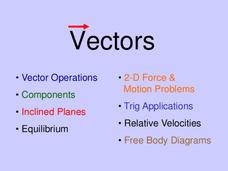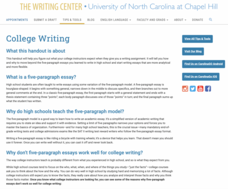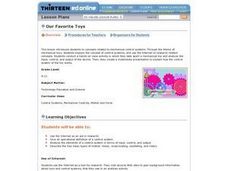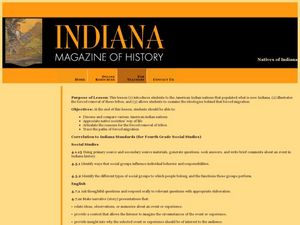Urbana School District
Vectors
I don't always make vector jokes, but when I do, IJK. Vector addition using multiple methods, scalar multiplication, vector subtraction, vector components, relative velocities, free body diagrams, and so much more Are covered in this...
Cornell University
Build a Fuel Cell
Discover the connection between redox reactions and fuel cells. Collaborative groups build a Hoffmann Apparatus that demonstrates the electrolysis of water and then convert their models into a fuel cell. They use their fuel cells to...
Museum of Science
Balloon Racers
Watch those balloon cars go! Scholars build racers that run using the power of balloons and conduct races with the cars. They learn about Newton's third law of motion and how it applies to their balloon racers.
Science Friday
Make a Speaker
Make science come in loud and clear. Pupils learn about how a speaker works by building one. The scholars first learn about electromagnetic fields by building an electromagnet. Using that knowledge, they build a crude speaker using a...
University of North Carolina
College Writing
No matter how difficult high school writing may seem, college writing presents challenges of its own. The fourth in a series of 24 handouts from The Writing Center at UNC breaks down the expectations for college writing. Scholars learn...
Teach Engineering
Magnetic Fluids
Teams work as material engineers to create ferrofluids, whose shape is influenced by magnetic fields. The activity, which is the fourth in the six-part series, has the teams create magnetic ink and use it to write, testing it with a...
Worksheet Web
Learning about Volcanoes
There's something about the classic volcano demonstration that can grab any learners' attention. Scholars begin with a reading and grand conversation about volcanoes, construct an erupting volcano using vinegar and baking soda, then...
Curated OER
A Model of Three Faults
Students investigate faults. In this science lesson, students explore the many stresses and strains in the earth's layers and research the types of faults in their state.
Curated OER
Our Favorite Toys
Pupils give an operational definition of a control system. They analyze the elements of a control system in terms of input, control, and output and describe the four basic types of motion: linear, reciprocating, oscillating, and rotary.
Curated OER
Suspension Bridge Construction
Students build a model of a suspension bridge and test the amount of weight it support. They identify different types of bridges: suspension, arch, girder, truss, cantilever, cable-stayed and moveable.
Curated OER
Stressed to a Fault!
Eighth graders describe how stress builds up in the Earth's crust by the movement of tectonic plates. In groups, they relate the three types of stresses to the types of plate movements and explain how the stress causes faults to form. ...
Curated OER
How Electric Current Produces Energy
Fifth graders are introduced to the concept of electric currents. In groups, they develop their own game board to test different circuits to determine if they are complete. They record their observations of the energy transfer between...
Curated OER
What a Drag
Learners learn examples of friction and drag, and suggest ways to reduce the impact of these forces. The equation that governs common frictional forces is introduced, and during a hands-on activity, students experimentally measure a...
Curated OER
Newton's 2nd Law
Fourth graders explore Newton's second law of motion, testing and identifying the characteristics of objects that makes them easier or harder to push. They identify what types of objects are the hardest to move, then test a variety of...
Curated OER
Integrating Biology-Muscles and Work
For this muscle and work worksheet, students read about aerobic, anaerobic and resistance exercise. They apply what they read and answer three questions about these three types of exercise.
Curated OER
Stick To It!
High schoolers compare different types of pressure sensitive adhesive tapes. They fevelop and carry out tests for variables affecting the force needed to peel tape off a surface. Students analyze the time needed to peel the tape with...
Curated OER
Simple Machine Research
Fifth graders demonstrate the ability to use scientific skills and Processes to describe forces that act upon objects to cause specific changes in motion. They identify and describe a science problem related to forces and simple machines.
Curated OER
Pasta Bridges
Students analyze the correct use of technology as it relates to math and science. In this science instructional activity, students investigate force and weight as it relates to building an object. They build a bridge and draw conclusion...
Curated OER
Rockets!!
Learners launch a rocket. In this laws of motion lesson, students discuss the forces of flight, how a plane flies and how a rocket gets off the ground. Learners watch a video about rocket launches, discuss Newton's Third Law...
Curated OER
Construction Technologies: Construct the Strongest Bridge
Students investigate how engineers use different types of bridges for different places. In small groups they design and construct bridges for three different scenarios, and answer a series of investigating questions applied to the...
Curated OER
Natives of Indiana
Fourth graders participate in discussions about the Native Peoples who inhabited what is now Indiana. In this Native American lesson, 4th graders discuss the social and cultural structures of these Native Americans. They locate the...
Curated OER
Backpacks and Hills
This machines PowerPoint reviews effort and force in relation to work and informs students about different types of machines and the different ways forces are applied and how they work to increase efficiency.
Curated OER
Heightening Awareness
Students review their prior knowledge about Haiti. They examine violence in Haiti by reading and discussing "HAITIAN FORCES BATTLING UPRISING REPORT RETAKING 3 TOWNS." In groups, students research specific time periods of Haitian history...
Curated OER
Catapult Creations
Third graders design and build a catapult. In this lever lesson, 3rd graders collect a variety of lever type objects. Students build a catapult and launch marshmallows or crumpled paper and see who can hit the designated target.























